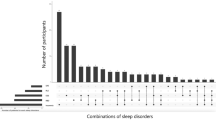Abstract
Sleep disorders occur in 74–98% of patients with idiopathic Parkinson’s disease (PD), adversely affecting their quality of life. Sleep disruption takes the form of sleep fragmentation with frequent and prolonged awakenings and daytime sleepiness. Nocturia, difficulty in turning over in bed, painful leg cramps, vivid dreams/nightmares, back pain, limb/facial dystonia and leg jerks are the main causes of nocturnal awakening in PD patients. Sleep disturbance gradually worsens with disease progression, suggesting that it is related to the severity of the disease. Sleep disturbances may be generally considered as part of the normal aging process, being more common in the elderly. However, no significant association between sleep disturbances and either age or disease duration was found in a survey of 100 PD patients. Disturbed sleep maintenance in PD patients was more severe than in age-matched controls, and nocturnal awakening was frequently caused by nocturia, pain, stiffness and difficulty in turning over in bed. Sleep disturbance is also a complication of chronic levodopa therapy. Recent data suggest that controlled-release levodopa is less likely to cause nocturnal symptoms than standard levodopa, particularly in mild-to-moderate disease. Depression, which is common in PD patients, contributes to sleep disturbance but has a lesser influence than the disease process itself. Hypnotic and sedative agents, as well as anti-depressants if required, are useful in ameliorating sleep disturbances in PD patients; intranasal desmopressin appears to be effective in reducing nocturia.
Similar content being viewed by others
References
Aldrich MS (1989) Parkinsonism. In: Kryger MH, Roth T, Dement WC (eds) Principles and practice of sleep medicine. Saunders. Philadelphia, pp 351–357
Askenasy JJM (1993) Sleep in Parkinson’s disease. Acta Neurol Scand 87: 167–170
Askenasy JJM, Yahr MD (1990) Parkinsonian tremor loses its alternating aspect during non-REM sleep and is inhibited by REM sleep. J Neurol Neurosurg Psychiatry 53: 749–753
Benca RM, Obermeyer WH, Thisted RA, Gillin JC (1992) Sleep and psychiatric disorders: a meta-analysis. Arch Gen Psychiatry 49: 651–668
Briskin JG, Lehrman KL, Guilleminault C (1978) Shy-Drager and sleep apnea. In: Guilleminault C, Dement W (eds) Sleep apnea syndromes. Liss, New York, pp 317–322
Culebras A (1992) Neuroanatomic and neurologic correlates of sleep disturbance. Neurology 42 [Suppl 6]: 19–27
Cummings JL (1992) Depression in Parkinson’s disease. Am J Psychiatry 149: 443–454
Factor SA, McAlarney T, Sanchez-Ramos JR, Weiner WJ (1990) Sleep disorders and sleep effects in Parkinson’s disease. Mov Disord 5: 280–285
Gross RA, Spehlmann R, Daniels JC (1978) Sleep disturbances in progressive supranuclear palsy. Electroencephalogr Clin Neurophysiol 45: 16–25
Jansen ENH, Meerwaldt JD (1988) Madopar HBS in Parkinsonian patients with nocturnal akinesia. Clin Neurol Neurosurg 90: 35–39
Kostic VS, Susic V, Przedborski S, Sternic N (1991) Sleep EEG in depressed and nondepressed patients with Parkinson’s disease. J Neuropsychiatry Clin Neurosci 3: 176–179
Lees AJ (1987) Sustained release of L-dopa (Madopar HBS) in the treatment of nocturnal and early morning disabilities in Parkinson’s disease. Eur Neurol 27 [Suppl 1]: 126–134
Lees AJ, Blackburn NA, Campbell VL (1988) The nighttime problems of Parkinson’s disease. Clin.Neuropharmacol 11: 512–519
Lesser RP, Fahn S, Snider SR, Cote LJ, Isgreen WP, Barrett RE (1979) Analysis of the clinical problems in parkinsonism and the complications of long-term levodopa therapy. Neurology 29: 1253–1260
Menza MA, Rosen RC (1995) Sleep in Parkinson’s disease. The role of depression and anxiety. Psychosomatics 36: 262–266
Montplaisir J, Champlain J de, Young SN, Missala K, Sourkes TL, Walsh J, Remillard G (1982) Narcolepsy and idiopathic hypersomnia: biogenic amines and related compounds in CSF. Neurology 32: 1299–1302
Nausieda PA, Weiner WJ, Kaplan LR, Weber S, Klawans HL (1982) Sleep disruption in the course of chronic levodopa therapy: an early feature of levodopa psychosis. Clin Neuropharmacol 5 [Suppl 2]: 183–194
Nicholson AN, Pascoe PA (1990) Dopaminergic transmission and the sleep-wakefulness continuum in man. Neuropharmacology 29: 411–417
Sforza E, Zucconi M, Petronelli R, Lugaresi E, Cirignotta F (1988) REM sleep behavioral disorders. Eur Neurol 28: 295–300
Singer C, Weiner WJ, Sanchez-Ramos JR (1992) Autonomic dysfunction in men with Parkinson’s disease. Eur Neurol 32: 134–140
Starkstein SE, Preziosi TJ, Robinson RG (1991) Sleep disorders, pain, and depression in Parkinson’s disease. Eur Neurol 31: 352–355
Suchowersky O, Furtado S, Rohs G (1995) Beneficial effects of intranasal desmopressin for nocturnal polyuria in Parkinson’s disease. Mov Disord 10: 337–340
Sweet RD, McDowell FH (1975) Five years treatment of Parkinson’s disease with levodopa. Ann Intern Med 83: 456–463
Van Hilten JJ, Weggeman M, Velde EA van der, Kerkhof GA, Dijk JC van, Roos RAC (1993) Sleep, excessive daytime sleepiness and fatigue in Parkinson’s disease. J Neural Transm 5: 235–244
Van Hilten B, Hoff JI, Middelkoop HAM, Velde EA van der, Kerkhof GA, Wauquier A, Kamphuisen HAC, Roos RAC (1994) Sleep disruption in Parkinson’s disease. Arch Neurol 51: 922–928
Author information
Authors and Affiliations
Rights and permissions
About this article
Cite this article
Partinen, M. Sleep disorder related to Parkinson’s disease. J Neurol 244 (Suppl 1), S3–S6 (1997). https://doi.org/10.1007/BF03160564
Issue Date:
DOI: https://doi.org/10.1007/BF03160564




